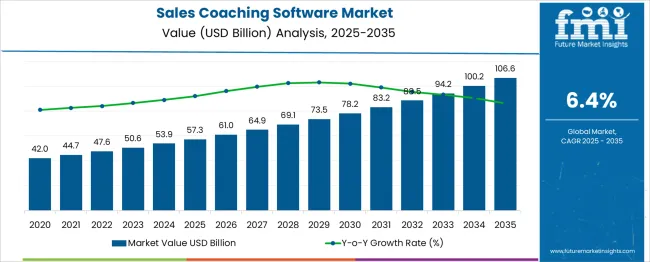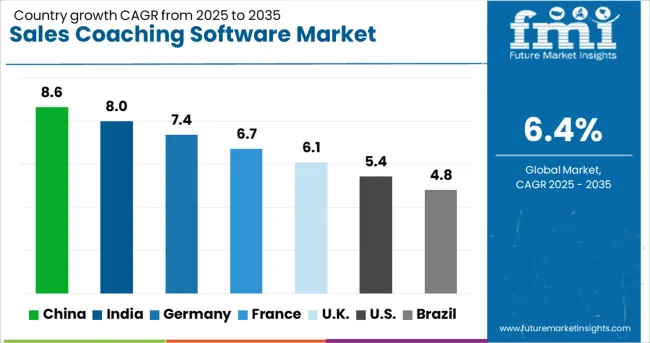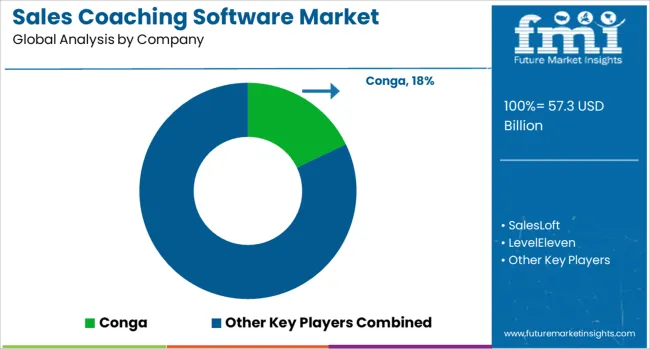The Sales Coaching Software Market is estimated to be valued at USD 57.3 billion in 2025 and is projected to reach USD 106.6 billion by 2035, registering a compound annual growth rate (CAGR) of 6.4% over the forecast period.

| Metric | Value |
|---|---|
| Sales Coaching Software Market Estimated Value in (2025 E) | USD 57.3 billion |
| Sales Coaching Software Market Forecast Value in (2035 F) | USD 106.6 billion |
| Forecast CAGR (2025 to 2035) | 6.4% |
A sales coaching program provides coaching through a variety of features including real-time feedback, analysis of customer interactions, and the signaling of upselling and close opportunities.
To meet that demand, such tools are becoming increasingly popular in the market for sales coaching software, thereby raising the prospects for the market's future growth. The product would be further optimized and advanced using the latest technological innovations and advancements, making it suitable for a wide variety of industrial and commercial applications.
In addition, organizations are becoming more inclined to use digital coaching tools, and their desire to improve long-term business prospects has contributed to the growth of the sales coaching software market. Employees can use this software if they wish to view the past communications of a client to comply with the growing demand for reviewing past conversations.
As technology advances and artificial intelligence (AI) is aiding live feeds to make performance evaluations more objective, there is a growing demand for sales coaching software in various parts of the world.
Managers and salespeople can collaborate and analyze emails and phone calls using sales coaching software. Improved sales close rate, improved sales techniques, and the setting of best practices can be achieved by this training.
The use of sales coaching and feedback can benefit everyone, from aspiring salespeople to talented professionals. In addition, the ramp time of a sales team can be shortened with the help of sales coaching tools since they enable them to identify areas for improvement quickly.
Software designed for sales coaching allows teams to align their approach and messaging when interacting with clients. In addition, the expected growth of the sales coaching software market can be attributed to the growing acceptance of digital coaching technologies among organizations, as well as the need to ensure long-term sales success.
Businesses can improve the effectiveness of their sales cycle by tracking deal risks, tracking adoption, and identifying the next steps with AI-based insights. As a key to business success, it is essential to strengthening learning through systematic and continuous learning. Developing sales training programs with sales coaching software can help with these initiatives. Keeping training concise can make it easier to spread them over a long period by breaking them down as needed.
Managers, executives, and sales coaches can work together to identify actions sales professionals need to implement and manage to develop their sales skills. In addition, to call tracking and web conferencing, software integrations also include sales performance tracking and CRM systems. By integrating data from your sales coaching software and existing systems, a business can know its customers better.
Coaches are capable of helping the sales team to develop both their skills and confidence. Onboarding will improve, turnover will be reduced, sales will rise, and revenue will be boosted. With ongoing sales coaching software, the return on investment will increase.
The impact will vary according to the ability of the coaching software. The efficacy of coaching sessions will increase as employees gain more experience dealing with challenges.
Sales training programs have virtually no chance of producing lasting results if they fail to analyze the real learning needs of their team. If businesses are not aware of what skills the team already has and where their weaknesses lie this will hamper the growth of the software that's relevant to them and is expected to hamper sales in the market.
Many sales training programs fail to teach employees how to move prospects through the funnel systematically. Training is easily forgotten without a systematic approach, and salespeople waste a lot of time and effort reinventing themselves. All these factors have hampered the growth of the market.
Cloud-based Sales Coaching Software to witness Maximum Uptake
Demand for Cloud-based sales coaching software is predicted to grow at the fastest rate during the forecast period. Cloud-based sales coaching software is projected to grow at a CAGR of 6.1% during the forecast period. The market is in the process of integrating new technologies to keep track of all the activities associated with all the sales that are being carried out. The market is adding AI and cloud-based sales coaching software into its product offering.
Cloud-based coaching software empowers coaches with the ability to manage clients' data in a centralized location, from client training plans to training histories, and much more. Clients can also receive automated updates on their performance via emails or text messages.
To offer highly personalized care management strategies, a host of companies have integrated machine learning algorithms. The market is also growing in part since companies are delivering real-time information via online channels, including smartphones and tablets.
Large Enterprises to be the Primary Application Area for Sales Coaching Software
Based on application, the large enterprise segment is projected to have the largest market share during the forecast period. It is anticipated that the market will increase at a 5.8% CAGR during the forecast period.
As part of the continuous training provided by sales coaching software, multiple features such as exclusive feedback from observers, upsell/close opportunities, and evidence-based conversations are available. Consequently, the industry is growing up along with the prominence of such applications in the market.

As the sales coaching software market is expected to grow, North America is expected to have the largest share of the market during the forecast period. This region is focusing primarily on providing flexible working hours to its employees which ultimately drives these companies to implement coaching tools such as SaaS to grow in the market.
The market for the USA is projected to grow at a value of USD 31.5 Billion with a CAGR of 6.2% during the forecast period. The USA holds the largest market for tech development and sales businesses in the online market. Growing demand for these businesses has significantly raised market demand for this software the market.
A growing regional market is also attributed to significant IT investment, technical advancements, and adoption of new technologies early on in their development. Large, medium, and small companies in the region are investing heavily in sales coaching software to maximize employee skills, and income and maintain market position.
The rapid digitalization of business activities has changed the dynamic of business processes over the last few years. Sales-related activities are streamlined and businesses are seeking effective solutions that can help them close leads faster and better performance to maintain client relations in the market.
The Asia-Pacific market for sales coaching software is expected to grow the fastest during the forecast period, followed by Europe. Asia-Pacific is projected to be the region to see increased demand for sales coaching, due to a growing need for customer service and training.
China accounts for 5.9% of revenue growth in the region. In addition to technological advancements, the expansion of IT firms in many developing nations has created a demand for sales coaching software sales. Growing online e-commerce businesses and retail sales are creating a market for sales coaching software in the market.
Over the forecast period, Japan is projected to achieve a CAGR of 5.2% in 2035. Demand for cloud storage systems and the increase of SMEs in this region are expected to support sales of cloud storage systems in this region. South Korea's market is expected to flourish at a 4.3% CAGR in the coming years. In addition, sales coaching software is becoming an increasingly popular tool to ensure customers experience an enhanced level of service, which presents an untapped opportunity for the sales coaching software market.
With flexible working hours, efficient business management practices, and reduced costs for organizations, the UK region is expected to have the third-largest share of the market over the forecast period. These factors will lead these organizations to adopt coaching software in the market.
The UK sales coaching software market is expected to grow at a compound annual growth rate of 5.4% over the forecast period. In addition, advances in artificial intelligence and the Internet of Things will lead to a greater demand for skill development and evaluation of employee performance in the market.
As the need for better customer services increases, cloud-based storage services and the integration of AI and ML will be of even greater importance. Due to the growing use of cellular devices and improvements in network access, consumers and businesses in the UK have become more reliant on customer-centric businesses that are strengthening the market for sales coaching software.

Through strategic partnerships, manufacturers can increase production and meet consumer demand, increasing both their revenues and market share. The introduction of new products and technologies will allow end-users to reap the benefits of new technologies. Increasing the company's production capacity is one of the potential benefits of a strategic partnership.
The global sales coaching software market is estimated to be valued at USD 57.3 billion in 2025.
The market size for the sales coaching software market is projected to reach USD 106.6 billion by 2035.
The sales coaching software market is expected to grow at a 6.4% CAGR between 2025 and 2035.
The key product types in sales coaching software market are cloud based and web-based.
In terms of application, large enterprises segment to command 66.4% share in the sales coaching software market in 2025.






Our Research Products

The "Full Research Suite" delivers actionable market intel, deep dives on markets or technologies, so clients act faster, cut risk, and unlock growth.

The Leaderboard benchmarks and ranks top vendors, classifying them as Established Leaders, Leading Challengers, or Disruptors & Challengers.

Locates where complements amplify value and substitutes erode it, forecasting net impact by horizon

We deliver granular, decision-grade intel: market sizing, 5-year forecasts, pricing, adoption, usage, revenue, and operational KPIs—plus competitor tracking, regulation, and value chains—across 60 countries broadly.

Spot the shifts before they hit your P&L. We track inflection points, adoption curves, pricing moves, and ecosystem plays to show where demand is heading, why it is changing, and what to do next across high-growth markets and disruptive tech

Real-time reads of user behavior. We track shifting priorities, perceptions of today’s and next-gen services, and provider experience, then pace how fast tech moves from trial to adoption, blending buyer, consumer, and channel inputs with social signals (#WhySwitch, #UX).

Partner with our analyst team to build a custom report designed around your business priorities. From analysing market trends to assessing competitors or crafting bespoke datasets, we tailor insights to your needs.
Supplier Intelligence
Discovery & Profiling
Capacity & Footprint
Performance & Risk
Compliance & Governance
Commercial Readiness
Who Supplies Whom
Scorecards & Shortlists
Playbooks & Docs
Category Intelligence
Definition & Scope
Demand & Use Cases
Cost Drivers
Market Structure
Supply Chain Map
Trade & Policy
Operating Norms
Deliverables
Buyer Intelligence
Account Basics
Spend & Scope
Procurement Model
Vendor Requirements
Terms & Policies
Entry Strategy
Pain Points & Triggers
Outputs
Pricing Analysis
Benchmarks
Trends
Should-Cost
Indexation
Landed Cost
Commercial Terms
Deliverables
Brand Analysis
Positioning & Value Prop
Share & Presence
Customer Evidence
Go-to-Market
Digital & Reputation
Compliance & Trust
KPIs & Gaps
Outputs
Full Research Suite comprises of:
Market outlook & trends analysis
Interviews & case studies
Strategic recommendations
Vendor profiles & capabilities analysis
5-year forecasts
8 regions and 60+ country-level data splits
Market segment data splits
12 months of continuous data updates
DELIVERED AS:
PDF EXCEL ONLINE
Salesforce Services Market Size and Share Forecast Outlook 2025 to 2035
Sales Analysis of Tourism Industry in the Middle East Size and Share Forecast Outlook 2025 to 2035
Sales of Sports Nutrition Products in Latin America Analysis Size and Share Forecast Outlook 2025 to 2035
Sales of Plant‑based Ready Meals in US Analysis - Size, Share & Forecast 2025 to 2035
Sales Enablement Platform Market Analysis - Size, Share, and Forecast 2025 to 2035
Sales Intelligence Market Size and Share Forecast Outlook 2025 to 2035
Sales of Used Bikes through Bike Marketplaces Market- Growth & Demand 2025 to 2035
Sales Platforms Software Market Size and Share Forecast Outlook 2025 to 2035
Sales Compensation Software Market Size and Share Forecast Outlook 2025 to 2035
Sales Intelligence Software Market Size and Share Forecast Outlook 2025 to 2035
Sales Training and Onboarding Software Market Size and Share Forecast Outlook 2025 to 2035
Sales Performance Management (SPM) Software Market Size and Share Forecast Outlook 2025 to 2035
Salesforce CRM Document Generation Software Market Size and Share Forecast Outlook 2025 to 2035
Retail Sales of Legume Snacks in the UK Analysis - Size, Share & Forecast 2025 to 2035
Retail Sales of Kvass in Russia and CIS countries Analysis - Size, Share & Forecast 2025 to 2035
Retail Sales of Layered Verrine‑Style Desserts in France Analysis - Size, Share & Forecast 2025 to 2035
US Convenience Confectionery Retail Sales Analysis - Size, Share & Forecast 2025 to 2035
Retail Sales of Bergamot from Calabria in Italy Analysis - Size, Share & Forecast 2025 to 2035
Generator Sales Market Size and Share Forecast Outlook 2025 to 2035
Demand and Sales Analysis of Paper Cup in Japan Size and Share Forecast Outlook 2025 to 2035

Thank you!
You will receive an email from our Business Development Manager. Please be sure to check your SPAM/JUNK folder too.
Chat With
MaRIA